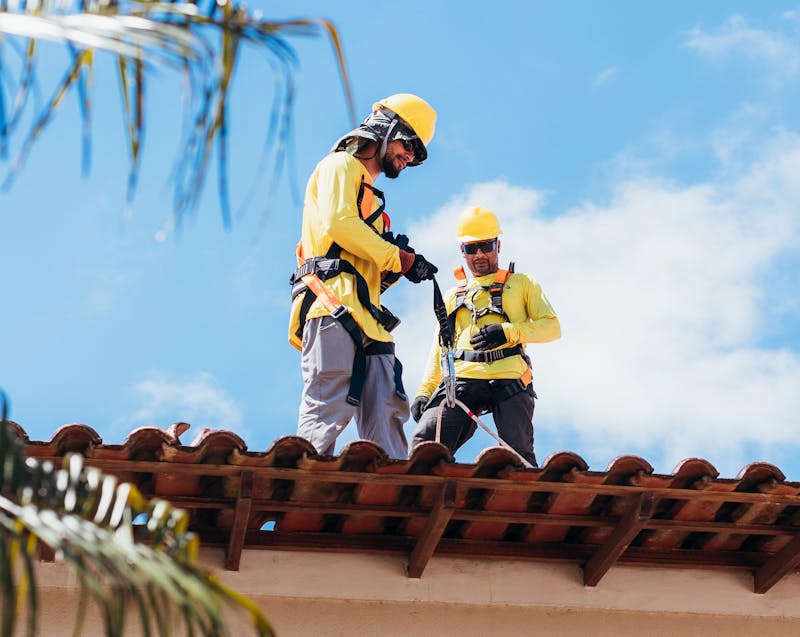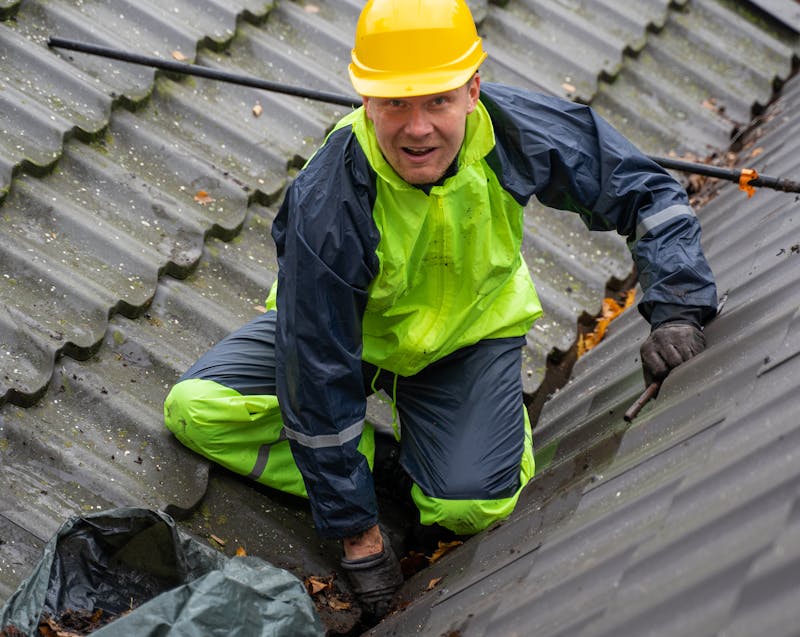
- A detailed roof damage assessment is essential for identifying both visible and hidden issues that affect insurance claims.
- Hiring a roofer with insurance claim experience ensures accurate documentation and fair communication with insurance adjusters.
- Roofers play a vital role in validating storm-related damage, preparing cost estimates, and advocating for fair compensation.
- Homeowners should choose licensed, reputable roofers familiar with insurance processes to avoid underpaid or denied claims.
- Preventive maintenance—such as annual inspections and gutter cleaning—reduces future damage and strengthens future claim approvals.
- Early action after a storm, supported by professional inspection and photo documentation, speeds up claim approval and prevents costly repairs.
Roof damage can happen suddenly—whether from a hailstorm, high winds, fallen debris, or long-term wear that’s worsened by weather. When it does, homeowners often face a stressful combination of repairs and insurance paperwork. Understanding how roof damage assessments work and what role a roofer plays during an insurance inspection can make a significant difference in the outcome of a claim.
A professional roofer with insurance claim experience is not just a repair expert but also a knowledgeable guide who helps homeowners navigate complex claim processes. They know how to properly inspect damage, document findings, and communicate with insurance adjusters to ensure fair compensation.
This article explains the entire roof damage assessment process, the key role a roofer plays during insurance inspections, and how to choose the right professional for the job.
Why Roof Damage Assessments Matter
A roof damage assessment is more than a visual check—it’s a structured evaluation of a home’s first line of defense. These assessments determine not only the extent of the damage but also whether it qualifies for insurance coverage.
Without a proper assessment, homeowners risk underestimating damage, which can lead to incomplete repairs or denied claims. A detailed inspection provides the documentation insurance companies require to verify that damage was caused by a covered event, such as a storm, rather than normal aging or neglect.
Here’s why professional assessments are crucial:
- Accurate Claim Filing: Insurers rely on clear, objective evidence. Detailed inspection reports make it easier to get approval for repairs or replacements.
- Hidden Damage Detection: Some issues, such as water infiltration or structural weakening, may not be visible immediately but can cause serious problems over time.
- Safety Assurance: A damaged roof may compromise a home’s structural integrity. Identifying hazards early prevents future risks.
- Financial Protection: A well-documented assessment helps homeowners receive fair compensation, minimizing out-of-pocket costs.
Roof damage assessments are especially critical after severe weather events. Even minor shingle displacement or granule loss can lead to leaks, mold, and insulation damage if left unaddressed.
Common Causes of Roof Damage That Trigger Insurance Claims
Insurance claims often follow specific types of damage caused by natural elements or accidents. Understanding these causes helps homeowners recognize when to call for a professional inspection.
- Storm and Wind Damage
Strong winds can lift or remove shingles, loosen flashing, and expose underlayment. This allows water to seep into the roof structure, causing leaks and rot over time. - Hail Damage
Hailstorms are among the most common causes of roof insurance claims. Hail impact can bruise shingles, crack tiles, or dent metal roofing. Even if the roof doesn’t leak immediately, these weak points can shorten its lifespan. - Water Damage
When gutters clog or flashing fails, rainwater may pool and penetrate beneath shingles. Over time, this moisture can lead to mold, wood rot, and insulation deterioration. - Fallen Trees and Debris
Branches or trees that fall on a roof during storms can cause punctures or structural damage. These situations often require urgent attention and documentation for insurance purposes. - Age-Related Wear vs. Storm Damage
A key distinction during insurance claims is whether damage results from aging or a specific storm event. A roofer with insurance claim experience can help differentiate between the two, ensuring homeowners don’t lose coverage for legitimate storm-related damage.
The Roof Damage Assessment Process Explained
The process of evaluating and reporting roof damage typically involves several key steps, each requiring precision and expertise. Understanding these stages helps homeowners know what to expect during inspections and claims.
- Initial Homeowner Inspection
After a storm, homeowners should perform a visual check from the ground. Look for missing shingles, dents in metal gutters, fallen branches, or water stains on ceilings inside the house. Avoid climbing onto the roof until it’s inspected professionally. - Professional Roofer Inspection
A qualified roofer performs a detailed evaluation using specialized tools and safety gear. They examine both the exterior and interior, checking for visible damage, moisture penetration, and weak spots. - Documentation and Evidence Collection
Roofers take photos, measurements, and notes of every affected area. They often use drones for aerial imagery or infrared scanners to detect hidden moisture. These details strengthen the homeowner’s insurance claim. - Damage Categorization
Each issue is classified by severity—minor (e.g., small leaks), moderate (e.g., shingle loss), or severe (e.g., structural damage). Categorization helps determine whether a repair or full replacement is required. - Estimate Preparation
After assessment, the roofer prepares a repair or replacement estimate, including material costs, labor, and timeframes. This estimate is crucial for insurance claim calculations. - Insurance Adjuster Visit
Insurance companies send an adjuster to verify the damage. Having a roofer with insurance claim experience present ensures that no detail is overlooked and that the adjuster’s report reflects the actual condition of the roof. - Final Assessment and Claim Submission
Once both parties agree on the findings, the roofer assists the homeowner in submitting the necessary documentation and cost estimates to the insurance company for final approval.
The Roofer’s Role During the Insurance Inspection
A roofer’s job goes far beyond repairing leaks—they act as advocates for homeowners during insurance inspections. Their expertise ensures that legitimate storm-related damage is correctly identified, documented, and presented to insurance adjusters.
Key responsibilities include:
- Inspection Support: Roofers conduct a joint walkthrough with the insurance adjuster, pointing out less visible damage, such as bruised shingles or lifted flashing, that could be missed during a cursory inspection.
- Technical Explanation: They clarify technical details about roofing materials, installation methods, and damage patterns to help adjusters make informed decisions.
- Accurate Documentation: Professional roofers provide detailed inspection reports, including photographs, written notes, and repair cost breakdowns.
- Damage Validation: They confirm which areas of the roof have sustained impact or structural issues directly resulting from covered events.
- Negotiation Assistance: Roofers familiar with insurance processes can communicate effectively with adjusters to ensure homeowners receive fair claim settlements.
When a roofer understands insurance claim procedures, they act as a vital bridge between the homeowner and the insurer. Their insight helps prevent miscommunication, delays, or denied claims caused by incomplete documentation.
How Roofers Help Maximize Your Insurance Claim
Homeowners often assume insurance adjusters handle everything, but that’s not always the case. Adjusters work within company guidelines, which may result in conservative estimates. A roofer with insurance claim experience can help ensure homeowners receive fair coverage.
Ways a roofer strengthens your claim:
- Thorough Evidence Collection: They gather comprehensive documentation—before-and-after photos, close-up images of damaged materials, and repair cost breakdowns.
- Accurate Cost Estimates: Roofers base their estimates on real-time material costs and local labor rates, ensuring claims reflect true repair or replacement values.
- Policy Interpretation Assistance: Experienced roofers understand how to read insurance policies to identify what’s covered and what isn’t.
- Timely Communication: They help homeowners meet submission deadlines, preventing delays or claim denials.
- Long-Term Value: Roofers recommend durable materials or upgrades that fit within insurance coverage, minimizing future repair needs.
Example scenario:
After a hailstorm, a homeowner reports roof leaks. The insurance adjuster initially classifies the damage as minor. However, the roofer provides drone photos and moisture readings showing deeper structural damage. With this evidence, the claim is re-evaluated and approved for full replacement—saving the homeowner thousands of dollars.
Choosing the Right Roofer for an Insurance Claim
Selecting the right roofer is one of the most critical decisions after roof damage occurs. Not all contractors understand the complexities of insurance claims, so homeowners should look for professionals who combine roofing expertise with insurance claim knowledge.
Key qualities to look for:
- Experience with Insurance Claims: Choose a roofer who has a proven track record of assisting homeowners through claim assessments and approvals.
- Proper Licensing and Insurance: Ensure the contractor holds valid licenses and liability insurance to protect both parties during repairs.
- Strong Local Reputation: Local roofers are familiar with regional weather patterns, building codes, and insurance requirements.
- Comprehensive Inspections: Reliable roofers perform detailed assessments, not just quick visual checks.
- Transparent Communication: A trustworthy roofer explains every step of the process, from inspection to claim filing and repair timelines.
- Written Estimates and Contracts: Always ask for a written estimate outlining materials, labor costs, and project scope.
Homeowners should avoid “storm chasers”—contractors who appear after major weather events offering cheap repairs or guaranteed claims. A reputable roofer with insurance claim experience will take a professional, transparent approach to inspections and repairs.
Common Myths About Roof Damage and Insurance Inspections
Many homeowners misunderstand how roof insurance claims work. These misconceptions can lead to missed opportunities or costly mistakes.
Myth 1: Minor damage isn’t worth filing a claim.
Even small leaks or missing shingles can cause major problems later. Filing a claim early prevents future complications and higher repair costs.
Myth 2: Insurance always covers a full replacement.
Coverage depends on policy terms and the extent of the damage. A roofer helps determine whether partial or full replacement is justified.
Myth 3: Only the insurance adjuster can inspect your roof.
Homeowners can and should hire their own roofer for an independent assessment to ensure fairness and accuracy.
Myth 4: Visible damage is the only concern.
Hidden issues like water penetration or underlayment damage can be just as serious and are often covered when properly documented.
Preventing Future Roof Damage
While insurance can help with unexpected damage, prevention remains the most cost-effective strategy. Regular maintenance and inspections reduce the likelihood of severe damage and improve your chances of claim approval when problems arise.
Preventive measures homeowners should take:
- Schedule Annual Inspections: Have your roof professionally inspected at least once a year and after major storms.
- Clean Gutters and Downspouts: To prevent pooling and leaks, make sure water flows freely.
- Trim Overhanging Branches: This will help you avoid falling debris during strong winds.
- Replace Worn Flashing: Damaged flashing around chimneys or vents is a common source of leaks.
- Document Roof Condition: Take photos periodically to show your roof’s pre-damage condition—useful evidence if a claim is needed later.
Consistent maintenance by a trusted roofer helps extend the roof’s life and creates a record of care that supports future insurance claims.
Conclusion
Understanding roof damage assessments and the role of a roofer in insurance inspections can transform a stressful situation into a manageable one. A professional roofer doesn’t just repair shingles—they protect homeowners’ investments by ensuring claims are handled accurately and fairly.
A roofer with insurance claim experience brings technical expertise, strong documentation skills, and clear communication with adjusters. Their involvement ensures that storm-related damage is properly identified, validated, and compensated.
Homeowners who act quickly after damage occurs—by scheduling inspections, documenting evidence, and hiring experienced professionals—can prevent further damage, avoid costly out-of-pocket expenses, and secure a safer, longer-lasting roof. In the end, working with the right roofer provides not only structural protection but also peace of mind knowing your home and investment are in capable hands.


